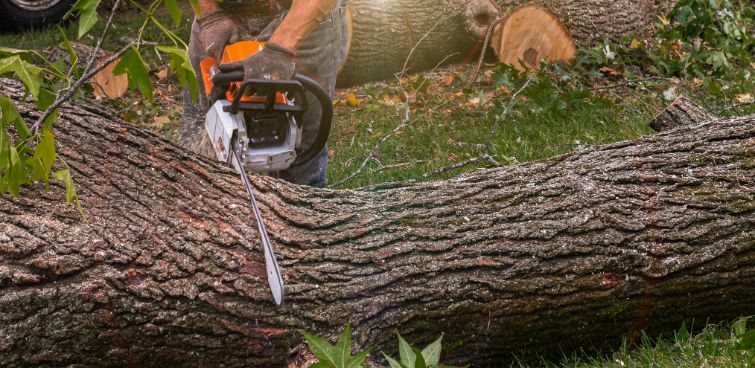The critical decision to arrange for tree felling should never be made lightly or without proper understanding of the ecological, safety, and legal implications involved. What appears to the untrained eye as simply “cutting down a tree” actually encompasses a sophisticated set of techniques requiring specialized knowledge, equipment, and experience to execute safely and responsibly.
Beyond the Chainsaw: The Science and Art of Tree Removal
Let’s be perfectly clear about what’s actually happening when a tree is professionally removed: this isn’t merely destruction—it’s a carefully orchestrated process that requires equal parts technical precision and environmental awareness. The romanticized image of someone simply attacking a trunk with a chainsaw bears little resemblance to the methodical, calculated approach that responsible arborists employ.
Professional tree felling involves complex assessments of tree structure, health, surrounding infrastructure, soil conditions, and potential failure points. It requires understanding how different species respond to cutting techniques and how their weight distribution affects their fall pattern. This knowledge isn’t academic—it’s literally life-saving.
“The difference between amateur and professional tree felling isn’t just about equipment or speed—it’s about the invisible calculations happening before a single cut is made. Each removal represents a unique engineering challenge that demands respect.”
The Safety Imperative
The dangers inherent in tree removal cannot be overstated:
- Unpredictable fall directions – Even experts must account for multiple variables affecting how a tree falls
- Hazardous structural weaknesses – Internal decay and damage may not be visible until cutting begins
- Dangerous kickback potential – Improper cutting techniques can cause violent tool reactions
- Power line proximity – Electrical hazards create potentially fatal complications
- Falling debris risks – Branches can break unpredictably during the removal process
These hazards explain why tree work consistently ranks among the most dangerous professions, with fatality rates that should give pause to anyone considering DIY approaches. The specialized equipment, techniques, and experience that professionals bring aren’t luxuries—they’re essential safeguards.
The Environmental Considerations
Beyond safety concerns, the environmental impact of tree removal demands thoughtful consideration. Every mature tree plays multiple ecological roles within its immediate surroundings, affecting:
- Local wildlife habitat and food sources
- Microclimate regulation through shading and evaporative cooling
- Stormwater management and erosion control
- Carbon sequestration and air quality improvement
- Soil health and structure
Responsible tree felling acknowledges these factors and includes mitigation strategies where appropriate. This might involve timing removals to minimize wildlife disruption, implementing erosion control measures, or recommending replacement plantings to maintain canopy coverage.
“The decision to remove a tree should never be made without considering its ecological context. What seems like a single isolated plant is actually a complex environmental system with impacts extending far beyond its physical footprint.”
The Regulatory Landscape
In many jurisdictions, the legal framework surrounding tree removal is increasingly stringent, reflecting growing recognition of trees’ environmental and community value. Navigating this regulatory environment requires specific knowledge that varies by location.
Professional arborists maintain current understanding of:
- Permit requirements for different tree species and sizes
- Protected tree designations and heritage status considerations
- Conservation area restrictions and environmental protections
- Neighbor notification requirements and dispute resolution processes
- Disposal regulations for removed material
Failure to adhere to these regulations can result in significant financial penalties and potential legal liability—costs that far exceed any perceived savings from unpermitted or unprofessional removal.
The Technical Process
The actual execution of tree felling involves sophisticated techniques developed through decades of industry experience. These approaches maximize safety while minimizing property damage and unnecessary environmental impact:
- Detailed pre-removal assessment of tree condition and surrounding area
- Strategic notch cutting to control fall direction with precision
- Sectional dismantling for trees in confined spaces
- Rigging systems to lower heavy sections safely in restricted areas
- Specialized equipment operation requiring extensive training
These techniques aren’t merely about efficiency—they represent essential risk management strategies that protect property, people, and the workers themselves.
The Aftermath Considerations
Professional tree removal doesn’t end when the tree hits the ground. Comprehensive service includes addressing:
- Stump removal or grinding options based on future land use
- Wood disposal or repurposing opportunities
- Site cleanup and restoration
- Soil remediation if necessary
- Recommendations for replacement plantings when appropriate
The Decision-Making Framework
Given these complexities, how should property owners approach the decision regarding tree removal? A responsible framework includes:
- Professional assessment of the tree’s condition and risk factors
- Clear understanding of the tree’s value (ecological, aesthetic, historical)
- Exploration of alternatives to complete removal when appropriate
- Consultation with relevant authorities regarding permits and regulations
- Selection of properly qualified and insured professionals
This deliberative approach recognizes that trees represent significant assets whose removal should be undertaken only after careful consideration of all factors.
Moving Forward Responsibly
As our understanding of urban ecosystems deepens and climate concerns intensify, the decision to remove trees will likely face increasing scrutiny from both regulatory authorities and community members. This isn’t unreasonable—mature trees represent decades of growth that cannot be quickly replaced, and their environmental benefits become more valuable as urban temperatures rise.
Those who approach tree removal decisions with appropriate seriousness and engage qualified professionals demonstrate environmental responsibility while protecting themselves from liability and safety risks. The additional investment in professional expertise pays dividends through reduced property damage, legal compliance, and the peace of mind that comes from knowing that all reasonable precautions have been taken in the complex process of tree felling.














Comments